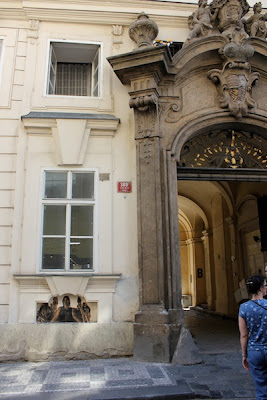
Upon returning from Kutna Hora, we had only a few hours in Prague before catching a bus to our first workstay in South Bohemia. The ride down was two-and-a-half hours of stunning scenery, transitioning from expansive farmland to densely-wooded forests; rolling hills to flatlands. We arrived at the bus station and were enthusiastically greeted by our new hosts, Nicola and Mike. After some brief introductions we all piled into the car and barreled down the road to Nový Mlýn - Nicola and Mike's sustainability project, where we were to be working for the next month and learning about various aspects of sustainable living, construction, cooking, farming, foraging, and living in a house-share community. The property consists of a huge white country house, surrounded by several barns in various states of disrepair (ranging from mildly bowed to appearing at first look to be ancient ruins), gardens (including one massive spiral-shaped bed), sprawling fruit trees, grazing fields, and a pond. Just beyond this sprawls a dense forest where a cornucopia of wild edibles like mushrooms, bilberries, and strawberries grow.





Nový Mlýn is an always-shifting project--new people from all around the world come and go, and new projects are constantly being undertaken and explored. Along with our fellow workers, Rosie, Tom, Lindsey and Helen, we've been sorting through the wood from the collapsed barns to separate re-usable wood from firewood, then using the good stuff to re-build the various outbuildings around the project area. All of the meals are shared, so everyone takes turns preparing feasts for the group of 8--we've been learning some new delicious recipes, as well as getting crash-courses in measurement conversions and cooking for a large group. On top of that, we've been helping take care of the animals; chickens (including some adorable chicks), ducks, sheep, goat, cats, and of course, Bunbury, the Rhodesian ridgeback.




When we're not working or cooking, we've been getting to know the Czech countryside and our housemates. After a particularly hot day of work, we drove out to an abandoned quarry to swim in its deep turquoise water. For the Fourth of July, we took a trip to an nearby town to go to an army surplus store--an amazing cache of Soviet war remnants that included a tank, and old piano, and, most importantly, huge boxes of fireworks. We lit them off and they traced huge arcs over the garden to explode grandly over the house. The sparks burned until they hit the wet grass of the garden, often indistinguishable from the fireflies' hovering.
We spend a lot of time exploring the surrounding forest, often searching for mushrooms to offer for communal meals, and along the way stumbling upon a myriad of natural treasures. We've seen iridescent blue scarabs, speckled blue eggs, auburn deer, bounding hares, algae-covered bones, gnarled antlers, countless mushrooms, and fireflies - all in our first weekend here.




























































